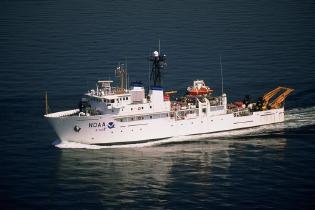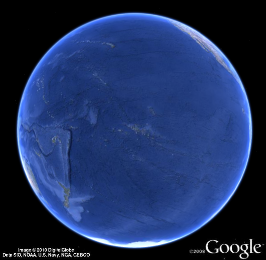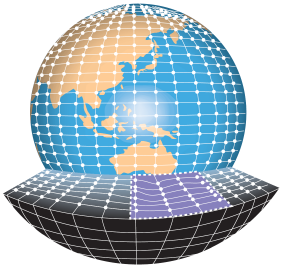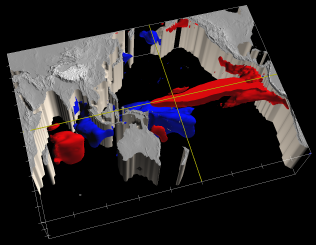Research Background
of Andrew Wittenberg
A view of Earth from its Pacific side. All the globe’s continents would fit within this single basin, with room to spare. Image: GoogleEarth.
T
he vast Pacific Ocean covers one third of the Earth’s surface, most of it within the tropics. Here, a confluence of factors — abundant sunlight and water vapor, a shallow oceanic thermocline, a reversal of the Coriolis effect at the equator, and an equatorial waveguide that spans 40% of the planet — spawns a rich spectrum of weather and climate variability in both the ocean and atmosphere. Much of this tropical variability teleconnects to far-flung regions, affecting weather, agriculture, fisheries, and terrestrial & marine ecosystems around the globe. Understanding and predicting this variability, in particular the El Niño / Southern Oscillation (ENSO), remains one of the great challenges of climatology and the atmospheric & oceanic sciences.
Doctoral Research (1997-2002)
My graduate work at Princeton University sought to explain observed variations in ENSO behavior, and the wide range of ENSO simulations among state-of-the-art coupled general circulation models (GCMs). Bringing together tropical Pacific observations, theoretical and GCM results, and a new statistical/dynamical hybrid model of El Niño, my dissertation showed how ENSO’s behavior and predictability were tied to key features of the climatological background state of the Pacific. It also alerted the climate community to major differences among the many surface wind stress products used to drive ocean models.

Sustained observations from ships, buoys,
and satellites are essential for building better climate models. During the autumn of 2000 I worked aboard the NOAA research ship Ka’imimoana, which maintains the TAO buoy array in the tropical Pacific. Image: NOAA.
Postdoctoral Research (2002-2004)
As a Princeton AOS postdoctoral fellow I developed a hybrid coupled GCM to investigate how model formulation, initial conditions, and stochastic forcing affect the simulation and prediction of ENSO. This model went on to serve the Geophysical Fluid Dynamics Laboratory (GFDL) in its award-winning research on advanced coupled data assimilation. It also helped researchers at Harvard University to develop an adjoint for the GFDL Modular Ocean Model (MOM), and colleagues at the International Research Institute (IRI) to do research on dynamical ENSO forecasts.
As a postdoc I suggested strategies for improving the atmospheric, oceanic, and coupled GCMs then under development at GFDL, based on tropical sensitivity studies done with those models and some intermediate-complexity analogs. The resulting CM2.0 and CM2.1 coupled GCM simulations of the tropical Pacific and ENSO are now widely regarded as among the best of those contributed to the Fourth Assessment Report of the Nobel-winning Intergovernmental Panel on Climate Change
(IPCC).
Earth system models (ESMs) apply physical, chemical, and biological equations to millions of cells in a 3-dimensional grid, tracking the flows of energy, momentum, water, salt, nutrients, gases, pollutants, and life through the global atmosphere, oceans, land, and ice. Image: BoM 2003.
GFDL Research Scientist (2004-Present)
Since joining NOAA I have maintained a keen interest in the tropics and climate change. Much of my work concerns the manifold aspects of El Niño: its sensitivities to climate change, model formulation, and stochastic forcing; its natural variability and predictability; and its impacts around the globe.
In this work, I utilize models at various levels of complexity — from fully coupled dynamical GCMs and hybrid statistical/dynamical models, to intermediate models and simple conceptual models. Currently my focus is on improving coupled GCMs, which are critical for climate forecasts and climate-change projections. In that regard I co-chair the GFDL Coupled Model Development Team (CMDT), which guides development of next-generation coupled GCMs to support future climate research and the IPCC Fifth Assessment.
Temperatures within the top 270 meters (900 feet) of the IndoPacific ocean, for an El Niño event simulated by the CM2.1 global coupled GCM. Red areas indicate warm water — more than 1°C (1.8°F) above normal — and blue areas are cold. Such changes impact fisheries, agriculture, and natural disasters worldwide. Image: NOAA GFDL.
Climate models must be firmly rooted in observations, and I am working on several fronts to help compare models with historical data from satellites, buoys, ships, and ocean/atmosphere reanalyses. At GFDL I have developed an extensive suite of automated diagnostics to evaluate the simulated tropics, ENSO, and global heat and water balances against observations, guided by theories of how these phenomena operate. To facilitate assessment and intercomparison of other models, I am working to make these analysis tools available to the international CLIVAR and CMIP communities. I also collaborate with GFDL scientists on advanced methods for fully-coupled data assimilation — to systematically confront models with observations, produce realistic global estimates of the historical climate system, and generate improved initial conditions for more reliable climate forecasts.





